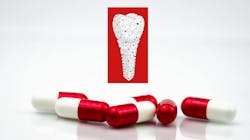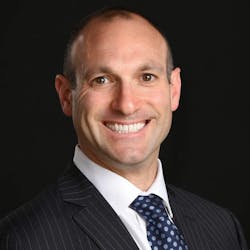Antibiotics: Are they needed for dental implant placement?
There are many reasons for dental implant failure, one of which is the development of bacteria around implants. Dental implants can develop bacteremia during the surgical placement of the dental implant, after the implant is placed prior to crown placement, and/or after the abutment and implant crown are delivered. This can result in soft-/hard-tissue loss around the implant (peri-implantitis). Antibiotic use prophylactically prior to surgery and postplacement is designed to prevent infections in the early stage of implant therapy.
Dental implant contamination: 3 reasons behind a late-stage failure
Dental implant failure and penicillin allergy, explained
Early implant failure is commonly associated with certain strains of bacteria. The most common bacteria involved are streptococci, anaerobic gram-positive cocci, and anaerobic gram-negative rods. Specifically, Prevotella intermedia, Prevotella nigrescens, Porphyromonas gingivalis, and Actinobacillus actinomycetemcomitans were all isolated from infected dental implants yielding similar strains to those seen with chronic periodontal disease.1
The aim of antibiotic use in implant dentistry is to use a bactericidal medication that prevents the onset of infection in the surgical wound by achieving an antibiotic concentration in the blood that will prevent bacterial proliferation and dissemination. Because the rate of postimplant placement infection is low to begin with, 1%–4.5%, the need for antibiotic coverage during implant therapy is controversial.2
What do the studies say regarding dental implant therapy and antibiotic use?
According to one large systematic literature review evaluating 11,406 implants placed, there was a 92% success rate when no antibiotics were used, a 96% success rate when antibiotic prophylaxis was used, and a 96% success rate when both prophylactic and postsurgical antibiotic coverage were used.3
Another multicenter clinical study evaluated 2,641 dental implants placed up until the stage II uncovering phase. Of these, 1,448 were placed in patients who had received prophylactic preoperative antibiotics, and 1,193 were placed in patients who did not receive antibiotic coverage. Fewer failures occurred when preoperative antibiotics were used (1.5% versus 4.0%).4 Additional studies agree and have shown that a single loading dose prior to implant surgery showed the same benefit as postplacement coverage for multiple days.5
Problems with antibiotic overuse
According to one study model, 5 million deaths worldwide in 2019 were attributed to antimicrobial resistance. This number is estimated to reach 10 million by 2050.6 In addition to concerns about resistance, there have been many adverse events reported with antibiotic use, involving direct toxicity, hypersensitivity reactions, and anaphylaxis.
Direct toxicity includes7
- Gastrointestinal disturbances such as nausea, vomiting, diarrhea, and abdominal pain
- Hematologic concerns such as neutropenia, thrombocytopenia, and hemolysis
- Gut dysbiosis leading to candida or pseudomembranous colitis
- Nephrotoxicity and hepatotoxicity
- Neuropathy
- Concomitant drug interactions and hepatobiliary issues (jaundice or hepatitis)
Hypersensitivity reactions include
- Rashes, dermatitis, urticaria
- Serum sickness, which is an immune complex condition
The most severe form is an immediate hypersensitivity including anaphylaxis, bronchospasms, or laryngeal edema.8 Of every million patients receiving just a single dose of oral amoxicillin, mild, moderate, and severe allergic reactions have been estimated to occur in 2,400, 400, and 0.9 patients, respectively.9 Because of all these problems with antibiotic overuse, the Centers for Disease Control and Prevention (CDC) has advocated many antibiotic stewardship protocols.10
What are the recommendations for antibiotic use when placing dental implants?
One very useful classification developed by Resnick and Misch bases the need for antibiotic coverage on patient medical history, type of surgery, degree of surgical complication, and length of the surgery.11
Category 1: Low risk
Infection risk is low, which includes simple implant placement (flap or no flap), nongrafted extractions, and second-stage surgery in healthy individuals. Antibiotics are not needed in these cases. 0.12% chlorhexidine (CHX) rinse is recommended pre- and postoperatively. This author recommends substituting StellaLife for CHX.
Category 2: Moderate risk
Infection risk is moderate, which involves traumatic extractions, socket preservation procedures, and immediate implant placements. A presurgical antibiotic loading followed by a single dose of antibiotic postsurgically is recommended. Use StellaLife rinse twice a day until sutures are removed.
Category 3: Moderate to high risk
Infection risk is moderate to high risk, which includes multiple implants with extensive soft-tissue reflection or immediate implant placements along with bone grafting and membrane. Use a preoperative loading dose of antibiotics followed by three postsurgical doses for a day to be continued for three days. Using StellaLife rinse twice a day until suture removal is also recommended.
Category 4: High risk
Infection risk is high, which includes implant surgeries that manipulate or enter the maxillary sinus, autogenous block bone grafts, and the same procedures as in categories 2 and 3 except for medically immune-compromised patients. Use a preoperative loading dose of antibiotics followed by three postsurgical doses for a day to be continued for five days. The use of StellaLife rinse twice a day until suture removal is recommended.
Category 5: Very high risk
Infection risk is high, which includes all lateral wall sinus augmentation procedures. Use a loading dose of antibiotics one day prior to the surgery (ensuring adequate levels in sinus tissues before surgery) and a beta-lactamase antibiotic, penicillin (Augmentin is the best choice), and cephalosporin for five days due to the high incidence of beta-lactamase pathogens in maxillary sinus infections. Use StellaLife rinse twice a day until suture removal and tissue closure is achieved.
Editor’s note: This article originally appeared in Perio-Implant Advisory, a chairside resource for dentists and hygienists that focuses on periodontal- and implant-related issues. Read more articles and subscribe to the newsletter.
References
- Heydenrijk K, Meijer HJA, van der Reijden WA, Raghoebar GM, Vissink A, Stegenga B. Microbiota around root-form endosseous implants: a review of the literature. Int J Oral Maxillofac Implants. 2002;17(6):829-838.
- Abu-Ta’a M, Quirynen M, Teughels W, van Steenberghe D. Asepsis during periodontal surgery involving oral implants and the usefulness of peri-operative antibiotics: a prospective, randomized, controlled clinical trial. J Clin Periodontol. 2008;35(1):58-63. doi:10.1111/j.1600-051X.2007.01162.x
- Ahmad N, Saad N. Effects of antibiotics on dental implants: a review. J Clin Med Res. 2012;4(1):1-6. doi:10.4021/jocmr658w
- Dent CD, Olson JW, Farish SE, et al. The influence of preoperative antibiotics on success of endosseous implants up to and including stage II surgery: a study of 2,641 implants. J Oral Maxillofac Surg. 1997;55(12 Suppl 5):19-24. doi:10.1016/s0278-2391(16)31193-4
- Binahmed A, Stoykewych A, Peterson L. Single preoperative dose versus long-term prophylactic antibiotic regimens in dental implant surgery. Int J Oral Maxillofac Implants. 2005;20(1):115-117.
- Antimicrobial Resistance Collaborators. Global burden of bacterial antimicrobial resistance in 2019: a systematic analysis. Lancet. 2022;399(10325):629-655. doi:10.1016/S0140-6736(21)02724-0 Erratum in: Lancet. 2022;400(10358):1102. doi:10.1016/S0140-6736(21)02653-2
- Ziment I. Complications of antibiotic therapy. Calif Med. 1972;117(5):24-48.
- Viola M, Quaratino D, Gaeta F, et al. Allergic reactions to antibiotics, mainly betalactams: facts and controversies. Eur Ann Allergy Clin Immunol. 2005;37(6):223-229.
- Gynther GW, Köndell PA, Moberg LE, Heimdahl A. Dental implant installation without antibiotic prophylaxis. Oral Surg Oral Med Oral Pathol Oral Radiol Endod. 1998;85(5):509-511. doi:10.1016/s1079-2104(98)90281-5
- Core elements of antibiotic stewardship. Centers for Disease Control and Prevention. National Center for Emerging and Zoonotic Infectious Diseases. Division of Healthcare Quality Promotion. Reviewed April 7, 2021. https://www.cdc.gov/antibiotic-use/core-elements/index.html
- Resnik RR, Misch C. Prophylactic antibiotic regimens in oral implantology: rationale and protocol. Implant Dent. 2008;17(2):142-150. doi:10.1097/ID.0b013e3181752b09
About the Author

Scott Froum, DDS
Editorial Director
Scott Froum, DDS, a graduate of the State University of New York, Stony Brook School of Dental Medicine, is a periodontist in private practice at 1110 2nd Avenue, Suite 305, New York City, New York. He is the editorial director of Perio-Implant Advisory and serves on the editorial advisory board of Dental Economics. Dr. Froum, a diplomate of both the American Academy of Periodontology and the American Academy of Osseointegration, is a volunteer professor in the postgraduate periodontal program at SUNY Stony Brook School of Dental Medicine. He is a PhD candidate in the field of functional and integrative nutrition. Contact him through his website at drscottfroum.com or (212) 751-8530.

